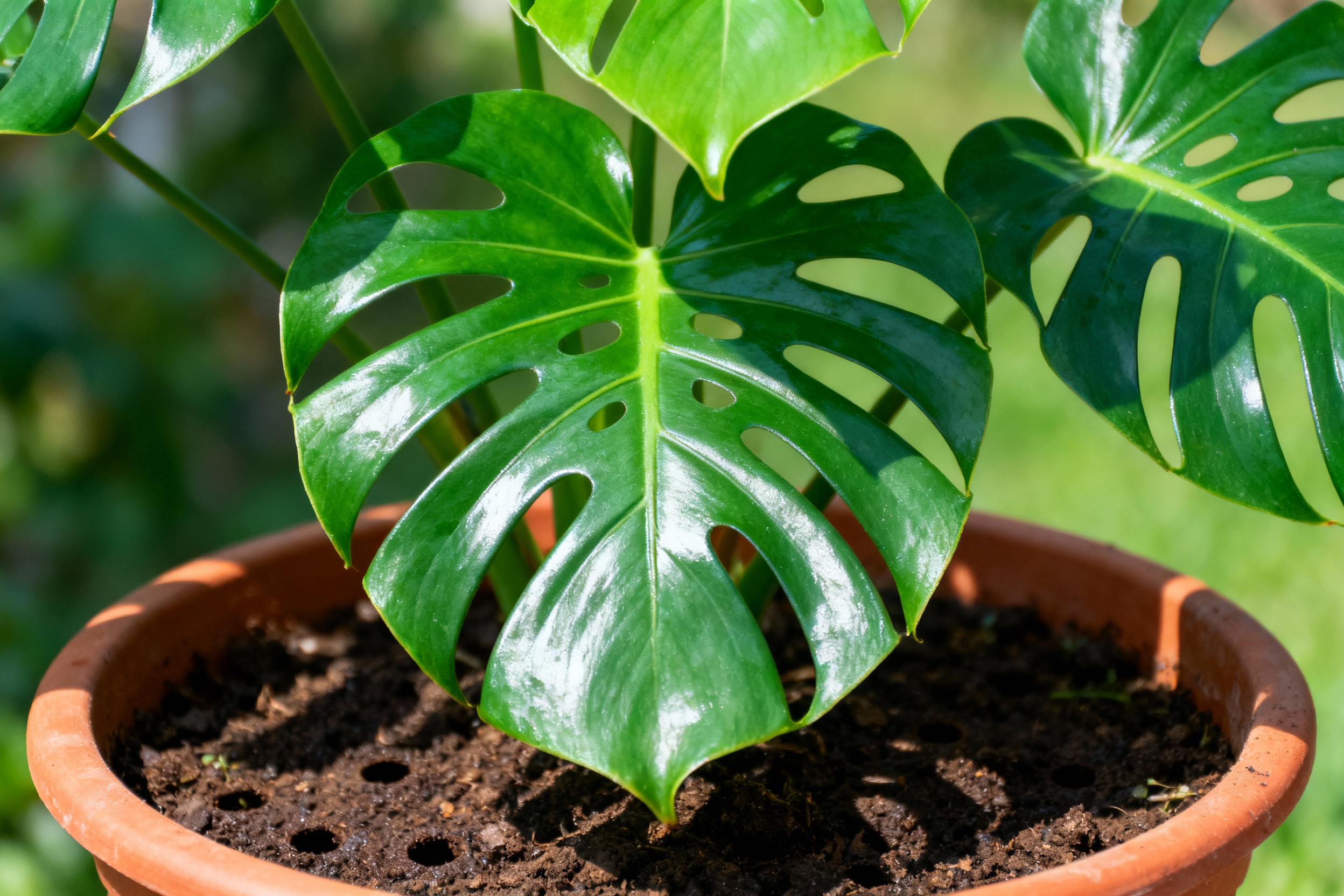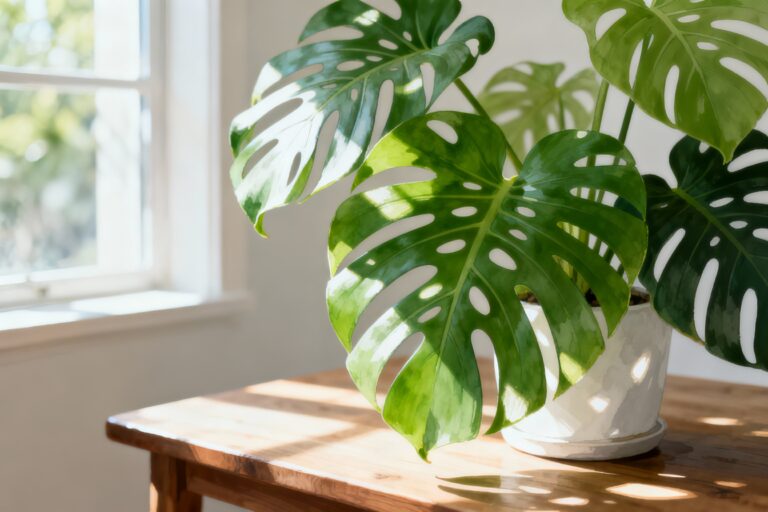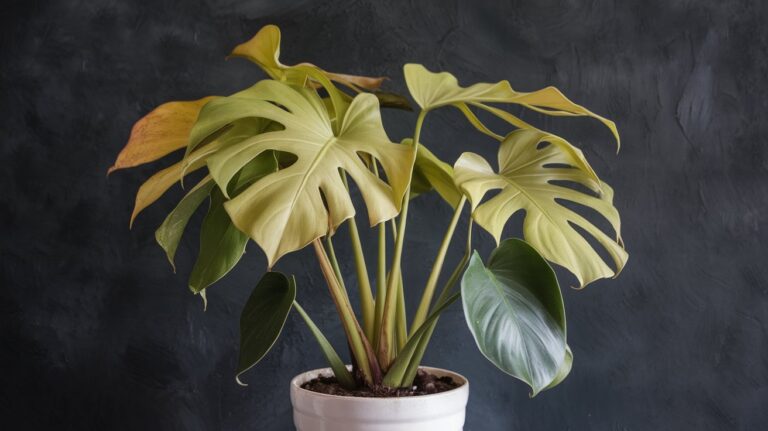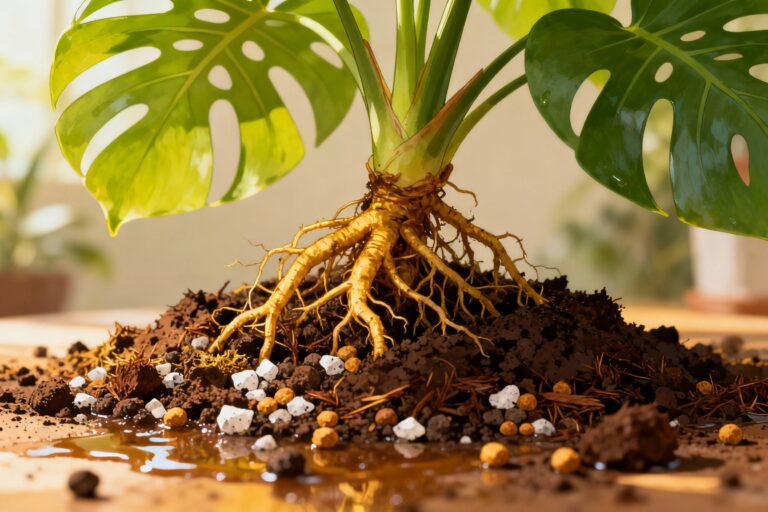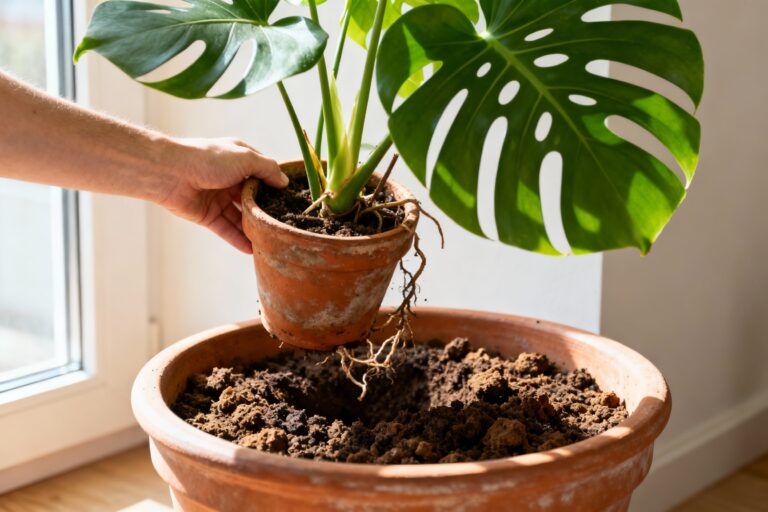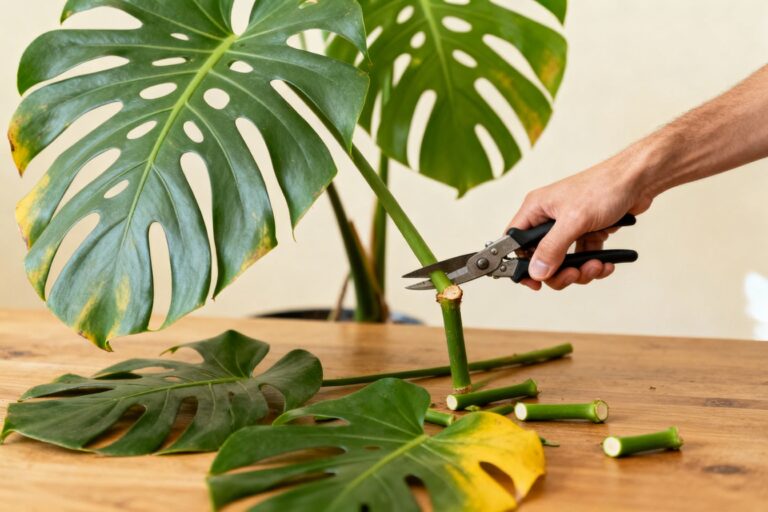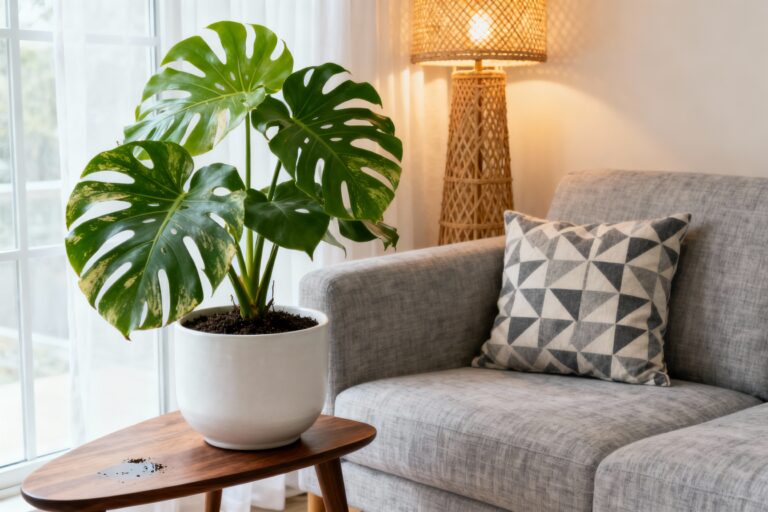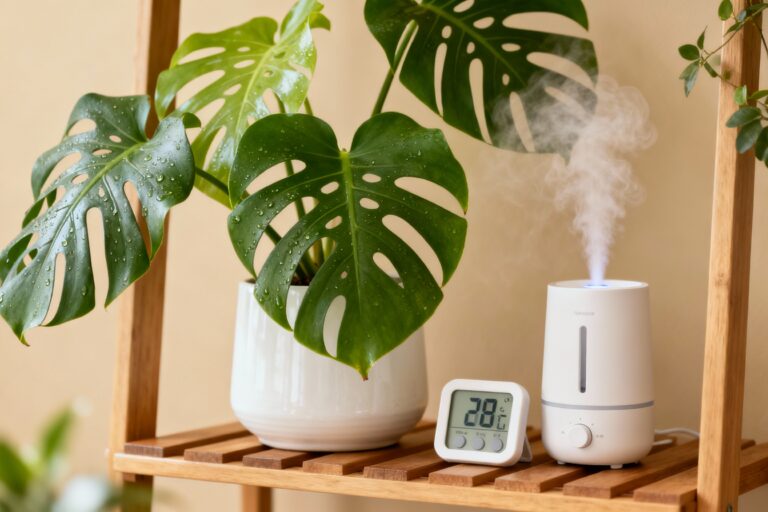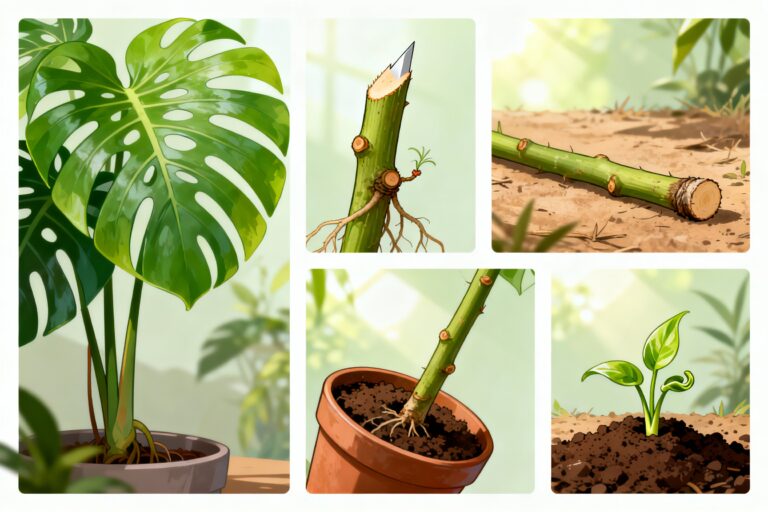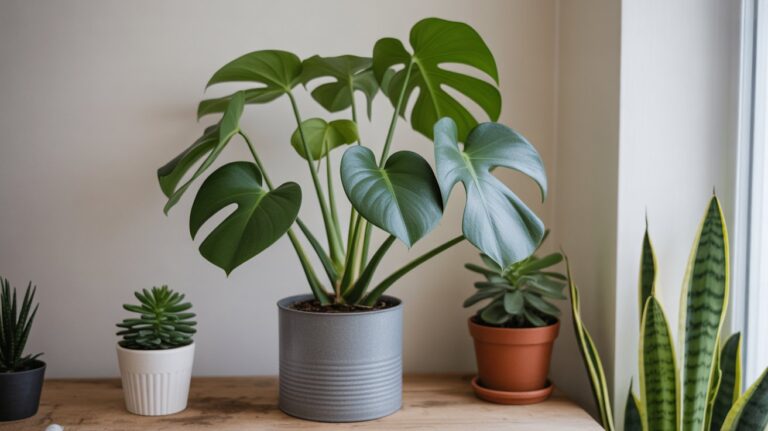You brought home a Monstera, huh? Excellent choice. Those dramatic leaves turn any room into a mini jungle—and yes, they can get big.
The catch? Monsteras want what they want. Give them the basics they crave and they’ll reward you with glossy, perforated leaves that scream “I thrive.” Let’s make that happen without the guesswork.
Light: The Deciding Factor for Those Iconic Holes
Monsteras love bright, indirect light.
Think “near a window but not sunbathing.” Direct, harsh sunlight can scorch leaves, while low light can stunt growth and delay those glorious fenestrations (the splits and holes). Best spots:
- Near east or north-facing windows
- Set back a few feet from a bright south or west window with a sheer curtain
Signs you nailed it: New leaves unfurl with splits, stems grow upright, and color looks deep green. Too little light? Long, leggy stems, smaller leaves, and no splits. Too much? Crispy edges, bleached patches, and a dramatic “why did you do this to me” vibe.
Grow Lights 101
No good windows? Use a full-spectrum LED grow light. Place it 12–24 inches above the plant and run it for 10–12 hours a day.
FYI: Monsteras respond well to consistent light schedules, so a simple outlet timer works wonders.
Watering: Less Guessing, More Checking
Monsteras prefer a good soak followed by a partial dry-out. Water when the top 2–3 inches of soil feels dry. Don’t just rely on your memory—use your finger or a moisture meter and become a plant detective. General rhythm:
- Spring/Summer: Every 7–10 days
- Fall/Winter: Every 10–14+ days
Overwatering signs: Yellowing leaves, mushy stems, fungus gnats. Underwatering signs: Droopy leaves that perk up post-watering, crispy edges.
The Perfect Watering Routine
Water thoroughly until it drains from the bottom, then empty the saucer.
If water runs straight through instantly, the soil likely compacted; give it a gentle aeration with a chopstick and consider repotting.
Soil and Potting: Give Those Roots Room to Breathe
Monsteras love chunky, airy soil. Regular potting mix alone compacts too easily. Aim for a well-draining mix that retains moisture but never turns swampy. My favorite blend (IMO):
- 40% high-quality potting mix
- 30% orchid bark
- 20% perlite or pumice
- 10% coco coir or peat moss
Pot size matters: Pick a pot 1–2 inches wider than the current one.
Too big and the soil stays wet for ages. Always use drainage holes. Always.
Repotting Timing
Repot every 1–2 years, ideally in spring.
Clues it’s time: roots circling the bottom, soil drying out unbelievably fast, or stunted growth. If the plant looks stressed post-repot, don’t panic—Monsteras sulk for a week, then bounce back.
Humidity and Temperature: Tropics, But Make It Manageable
Monsteras come from humid forests, so they thrive with moderate to high humidity. You don’t need a rainforest, but aim for 50–60% humidity if possible. Easy humidity boosts:
- Group plants together
- Use a pebble tray with water (plant sits above, not in)
- Run a small humidifier nearby
Temperature sweet spot: 65–80°F (18–27°C).
Keep them away from cold drafts, heat vents, and AC blasts. Sudden temperature changes = dramatic leaf droop. They’re divas like that.
Support and Pruning: Train the Climber
Monsteras are natural climbers that produce aerial roots.
Give them something to climb and they’ll reward you with larger leaves and more fenestrations. Support options:
- Moss pole (classic and chic)
- Coco coir pole (low maintenance)
- Trellis or stake (clean and minimal)
Tie stems loosely with soft plant ties and guide them upward. Those aerial roots? You can tuck them into the pole or the potting mix.
They’re not creepy, they’re helpful. Pruning tips:
- Cut leggy or damaged stems above a node
- Use clean, sharp shears to avoid infection
- Prune in spring for best recovery
Propagation, Because You’ll Want More
Take a cutting with at least one node (the bump on the stem) and a leaf. Root it in water or directly in soil. Change water weekly or keep soil lightly moist.
New roots appear in a few weeks. Boom—free plants.
Fertilizing: Fuel the Growth, Don’t Overdo It
During spring and summer, feed your Monstera regularly. You don’t need fancy formulas; consistency beats hype. Simple plan:
- Use a balanced liquid fertilizer (like 1-1-1 or 3-1-2)
- Apply at half strength every 4 weeks in the growing season
- Skip or reduce feeding in fall/winter
If you see salt crust on soil or leaves tip-burn, flush the soil with plain water to remove excess.
More fertilizer does not equal faster fenestrations. I wish.
Pests and Problems: Catch Them Early
Healthy Monsteras resist pests, but it happens. Check leaves (top and underside) when you water. Common culprits:
- Spider mites: Fine webbing, speckled leaves
- Mealybugs: Cottony clumps on stems and nodes
- Scale: Hard brown bumps that don’t rub off easily
- Fungus gnats: Tiny flies when soil stays too wet
Quick fixes:
- Wipe leaves with a damp cloth regularly
- Use insecticidal soap or neem oil weekly until pests vanish
- Let soil dry more between waterings to deter gnats
Yellow Leaves: What’s Going On?
Yellowing can mean overwatering, poor drainage, or old leaves retiring.
Check the roots—healthy roots look white and firm. Trim any brown, mushy roots and refresh the soil. If only a single lower leaf yellows, it might just be aging.
Don’t spiral.
Styling and Safety: Make It Look Good (and Keep Pets Safe)
Monsteras look best with space to spread and a tall support. Rotate the pot weekly so it grows evenly toward the light. Dust the leaves so they can photosynthesize like champs. Pet safety: Monsteras are toxic to pets if chewed.
Keep them out of nibble range, especially if your cat applies for the role of “Leaf Inspector.” Consider a plant stand, training, or a gentle pet deterrent spray.
FAQ
Why doesn’t my Monstera have holes yet?
Fenestrations develop with age and adequate light. Provide bright, indirect light, a support to climb, and steady watering. If your plant is still young or living in dim corners, it may take time—patience, grasshopper.
Can I grow a Monstera in low light?
It will survive, but it won’t thrive.
Expect smaller leaves, slower growth, and fewer (or zero) splits. If low light is your reality, add a grow light to keep the vibe lush, IMO.
How do I know when to upsize the pot?
Water dries out super fast, roots peek out the drainage holes, or growth stalls. If you see roots circling when you slide the plant out, go up 1–2 inches in pot diameter.
Repot in spring if you can.
Should I mist my Monstera?
You can, but it doesn’t move the humidity needle much. Misting helps with dust and looks cute on Instagram, but a humidifier or grouping plants works better. If you mist, do it in the morning so leaves dry quickly.
What’s the best way to clean the leaves?
Wipe with a damp microfiber cloth and a splash of lukewarm water.
Add a drop of gentle dish soap if they’re grimy. Skip leaf shine sprays—they can clog pores and attract dust. Shiny is great; suffocated is not.
Can I cut back a huge Monstera without killing it?
Absolutely.
Monsteras handle pruning well. Cut just above a node, and you can propagate the offcuts. It’s basically a free haircut and a new plant—win-win, FYI.
Conclusion
Monsteras aren’t high-maintenance; they’re just particular.
Give them bright, indirect light, water thoughtfully, use airy soil, and offer a pole to climb. Handle pests fast, feed during the growing season, and enjoy the jungle drama. Do that, and your Monstera will go from “cute plant” to “statement piece,” IMO.
